From Nano-drawings with DNA to Nano-Robots

|
Here what I desctibe is DNA as a structural material itself regardless of any other functions. This is slightly different to my post on building Programming languages and computers with DNA OR my post on protein folding.
This is important since DNA folds itself. As you started with a single strand of DNA and the bases of that chain would like to pair and reach a double strand chain. The staple is nothing more than a small section that is complementary to a sector of the single strand of DNA that when united forms something similar to a knot. Although the term is DNA origami at the moment is closer to DNA knitting.
The important details one needs to remember about DNA are:
- It has a ladder structure with antiparallel strands.
- Right-handed twist with 10.5 base pairs per turn
- Adenine(A) pairs with Thymine(T), and Cytosine(C) pairs Guanine(G).
Thanks to Nadrian Seeman's work on holiday junctions, by creating porous crystal out of DNA, one could take a protein and dock it into each cell. So the crystals order could be imposed on the protein to make the x-ray crystallography of large molecules easier.
In his article in scientific American in 2007, Seeman describes the story of his work. How the idea came to be and all the promises he once thought could this approach bring. After 30 years of work in the field, he has helped create an entirely new field.
A first landmark was a DNA cube. in 1991[2], where each edge of the wireframe cube is two turns of a double helix. Each face is a circular strand of DNA and the cube has a size of 10nm.
A holiday junction is a motif double-stranded structure that when combined with tertiary structure changes like coaxial stacking adds structural rigidity. The sequences like to stack into two double helices structures that are connected at a joint. When you have such structure it can flex on an axis, like a foldable chair. Thus using two of them makes the structure immovable.[3]
When you put them in sectors of proteins, you form something akin to Lego blocks. Which diminishes the energy necessary for self-assembly. By this one can get a two-dimensional lattice of arbitrary length.
In 2006, Paul Rothemund found a way to create two-dimensional shapes out of DNA. He called it DNA origami.[4]
You start with a long piece of single-stranded DNA. Once you make a fold you need to fix that shape with another piece of DNA called a 'staple strand'. Then you fold and fold until you obtain a shape.
The next step was to take this 2D tiles and make them into highly complex figures. Rothemund at CalTech, took the 7,000 base genome of the M13 Bacteriophage. Based on the known structure a series of oligonucleotides -20-60 bases long- that due to DNA complementarity will pinch the helix into an array of helices after heating at 65° Celsius and colling at room temperature. A type of tempering.

 animated representation that self-
animated representation that self-
assembles due to single and double crossings
The actual event is at the moment close to a black box. You input the right sequences and they have a high probability of self-assembly into the desired structure. By adding dumb bell endings at the end of the sequences you could get a small protuberance, giving a sort of setoff. That allows for visual marking and using the structure as a breadboard.
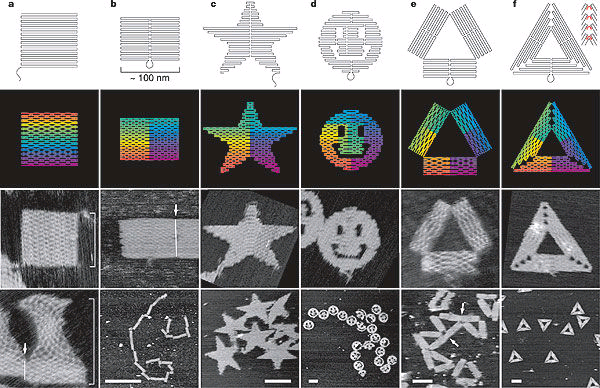
The first structures were 2D but soon the technology scaled and some groups started to develop 3D structures. Like folding sheets of paper.
A small parenthesis. The mathematics of origami folding are quite powerful. In fact you can solve problems with origami like "trisecting" an angle that are imposible with regular plane geometry. You can at the moment use software solutions like Origamizer to create without too much previous knowlede, complex structures.
The same mathematical principles used to predict how to take a sheet of paper to a 3D object are used to predict how to fold long structures made out of long sheets of DNA. At the moment the complexity is severely constrained due to technical difficulties but we are getting closer.

Took the original sheets and programmed them to fold up into a three-dimensional hollow box.[5] of aroung 42x36x36nm3. With a lid that opens in response to activation by a specific molecule, like a key to a lock. The obvious use would be something like the transport of drugs or other nanocargos.[6]
At the moment is already possible to create DNA blueprints. That map orthogonal projections of the desired structures for the building.
The graphical interface makes it accessible for interdisciplinary work and a lot faster. An interesting application is cadnano which allows for arbitrary design of 3D blueprints.[7]
The construction of even bigger structures can be achieved through tricks like Schlegel diagrams. You get the figures that have fixed parts that can combine at foldable joints to make for instance an icosahedron, only in a test tube. To create an object the size of a medium-sized virus. Huge in terms of nanostructure constructions. The future holds even bigger and more complex structures.
Since DNA can be easily coiled up, one can arrange the structure into three helices. When the coil structures interact side by side you can obtain curved sheets -Like corrugated paper- that are kinetically more intensive. This means the preparation time is longer. From an hour to a week.[8] The preference for 3D structures for particular sequences of change in temperature is something chocolatiers are quite familiar with during tempering an is also a problem of Nucleation and phase changes.
There's an important difference between this DNA-crystal like structures and synthetic nanoscale crystals. In the former case, each element of the object is associated with a unique sequence which means is independently addressable.[9]
At the Ohio State University. The construction of basic mechanical pieces using macroscale tools is already enjoying moderate success. Here are depicted simple mechanisms for hinges.[10]

Circular and linear motion has already been shown to be possible. including reversible movement.[11] Which could be harnessed to create crank-slider tools for pulleys and in the future even motors.
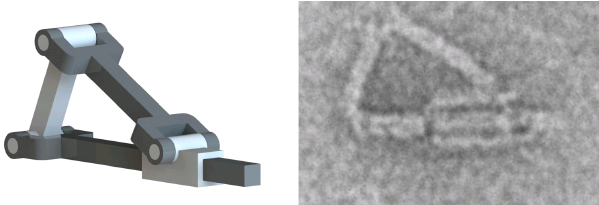
While at the moment the real applications are limited, the upside is dynamic interactions are possible with huge reserves of energy provided by the environment. Effectively speaking primitive self-assembling and self-sustainable nanomachines.[11]
One of the first not so far in the future applications is the recovery of the cellular matrix. Most of the architecture that gets damaged due to aging would receive a sort of reinforcement. I'm talking about making skin look young again. Providing support to articular tissues like knees and hips. In combination with stem cells could provide the birth of a new field. Regenerative medicine. Imagine an injection and boom, now your lost limb is back or your skin looks like when you were 18. Only wild imagination at the moment.
Some even think about transformers, not like in the movies but
I do understand my hype comes from the closeness to my field but the combination of design, engineering, mathematics, biology, physics, and programming makes this emerging field so beautiful. So tremendously beautiful.

References:
Images referenced. Modified, from google images labeled for reuse.


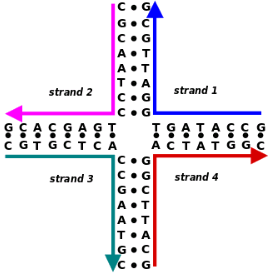

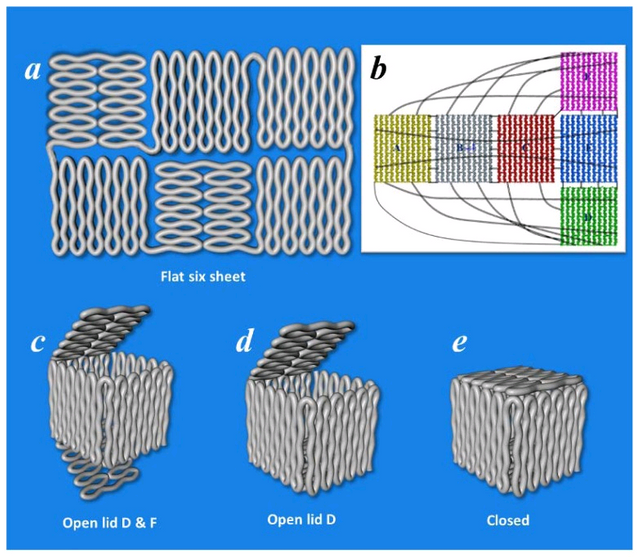
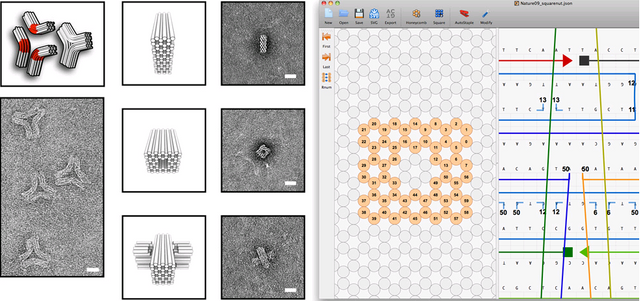


This is cool to see here. I just took a class with Dr. Castro at OSU who is one of the main researchers for this project. Great guy.
Awesome, I expect to meet him this year. I'm a fan of his work.
I can't wait to see where this will go for.
The future is here fellows.🚀
That is very cool and I tried to make a bunny based on the video but instead created a brilliant cabbage.
Holy Shit-Snacks! you are a Natural!
Huge for advances in supramolecular chemistry and self-assembly. I envision drug-delivery vehicles where one can use a heat-pack or sauna to melt away structured DNA to release cargo. DNA self-assembly also recently broke the gigadalton size milestone!
Well done posting, thank you!
Yeah! That's super recent news. Just read the Wagenbauer, Sigl and Dietz paper a week ago. A great time to be alive indeed. Not only that but the cost is gonna lower, I mean man. Just awesome stuff.
Awesome post. I never knew DNA was being developed as a structural material. It does make sense in some fashion as its a very stable molecule designed to preserve our genetic material. It's only weakness would be nucleases which may be the limiting factor of these structures.
It can be taken into account in order to give more stability to the structure. There are tricks here and there but yeah, is something to be vigilant of.
Very cool
Thank you for sharing, great stuff! Do you think that at some points these nanomachines could be used as "gates and conductors for biological transistors and diodes", for building biocomputers, or other approaches to that are more viable?
Yeah, indeed my previous post is about it. Check it out.
Thank you! I read it ASAP! :)
actually so cool, microscopic patterns, WOW. i am excited to where future will lead more. if they managed to draw with DNA :D what's next goal. but still cancer remains unbeatable but this achievements i think soon will change impossible into possible :)
The next goal is creating artificial cell organelles. Like mitochondria. Welcome to the future.
I must say this is a fantastically written article, I never knew origami could be applied to such molecular level. Which by the way is my ex-favourite hobby. Nonetheless the possibility with this new technology, now all we have to do is just wait and see if we can actually apply this properly and integrate it.
Good post sir! This technology can change our understanding of gene regulation, even more, if we can manipulate the DNA sequence and folding we can design a custom genome someday.
Imagine signing your own designed DNA, like is a painting.